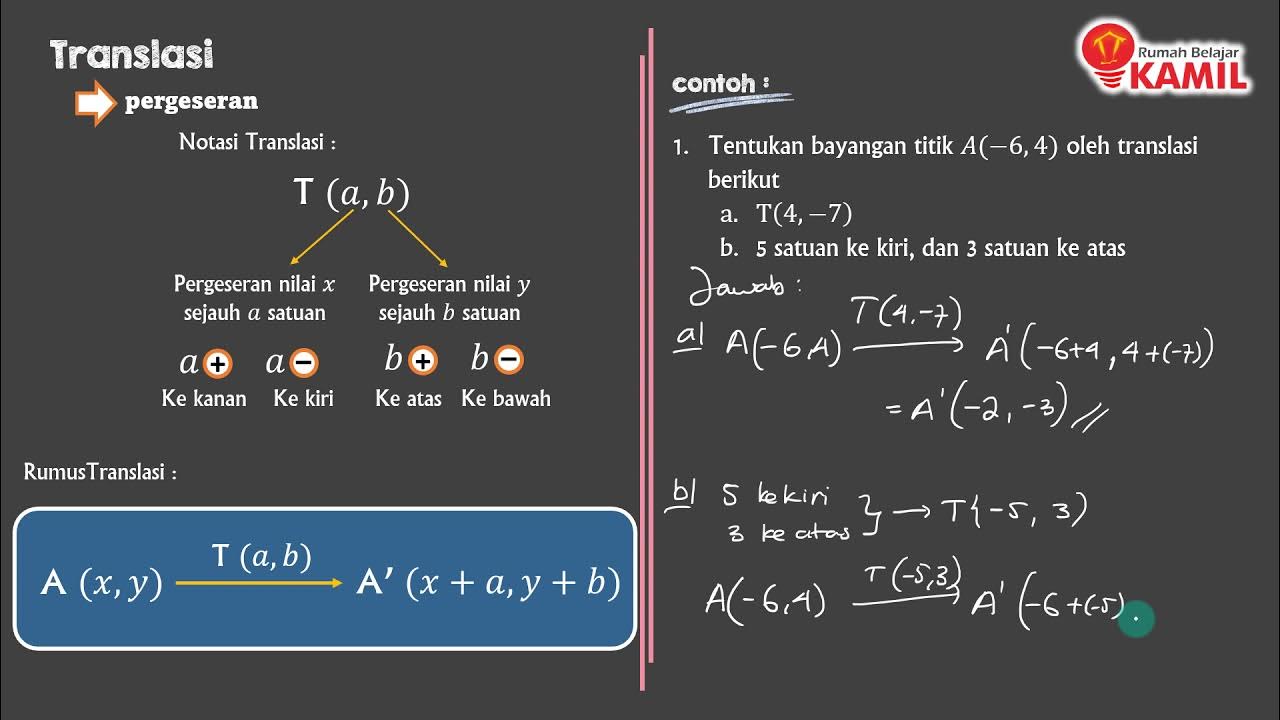TRANSFORMASI (PART 3) : DILATASI : MATEMATIKA KELAS 9 SMP
Summary
TLDRIn this educational video, Kak Feb explains the concept of dilatation in geometry, a transformation that alters the size and position of shapes without changing their form. The video covers key terms like scale factor (k) and center of dilation, demonstrating how these affect geometric shapes like triangles. Through step-by-step examples, viewers learn to apply the dilatation formulas and solve problems involving scaling and shifting points. The lesson encourages viewers to take notes for better understanding and to engage with Sigma Smart Study for further learning.
Takeaways
- 😀 Dilatation is a geometric transformation that changes the position and size of a figure, either enlarging or shrinking it without altering its shape.
- 😀 The scale factor, denoted by 'k', is a key concept in dilatation, which determines how much a figure is enlarged or reduced.
- 😀 The center of dilatation is the reference point from which the transformation occurs. In many cases, this center is at the origin (0, 0).
- 😀 If the scale factor (k) is greater than 1, the dilatation enlarges the figure while maintaining its shape and orientation.
- 😀 If the scale factor (k) is between 0 and 1, the dilatation shrinks the figure while preserving its shape.
- 😀 A negative scale factor results in a reflection and resizing of the figure, with the transformation occurring in reverse orientation.
- 😀 Dilatation with a scale factor less than -1 causes the figure to enlarge, but it is reflected (inverted) along the center of dilatation.
- 😀 The formula for dilatation with a center at the origin (0, 0) is: (k * x, k * y), where (x, y) are the coordinates of the original points.
- 😀 Dilatation with a center other than the origin uses the formula: (k * (x - a) + a, k * (y - b) + b), where (a, b) is the center of dilatation.
- 😀 In examples, students practice finding new coordinates after applying a scale factor, such as when dilating triangles with different scale factors and centers.
- 😀 It's important to visualize the results of dilatation through graphical representation, which helps students understand the changes in shape and position.
Q & A
What is dilation in geometry?
-Dilation is a mathematical transformation that changes the position and size of a figure. It can either enlarge or reduce the figure without altering its shape.
What is the significance of the scale factor (k) in dilation?
-The scale factor (k) is a value that determines how much the figure will be enlarged or reduced. A scale factor greater than 1 enlarges the figure, while a scale factor between 0 and 1 shrinks it.
What does the center of dilation refer to?
-The center of dilation is the reference point from which the dilation occurs. It serves as the origin point for the transformation, affecting the positioning of the dilated figure.
What happens when the scale factor is greater than 1?
-When the scale factor is greater than 1, the result of the dilation is an enlargement of the figure, maintaining the same shape but increasing in size.
What happens if the scale factor is less than 1 but greater than 0?
-If the scale factor is between 0 and 1, the figure will be reduced in size, maintaining the shape but shrinking in proportion.
What occurs when the scale factor is between -1 and 0?
-When the scale factor is between -1 and 0, the figure is reduced in size, but it is reflected (flipped), making it not congruent or the same as the original figure.
What happens if the scale factor is less than -1?
-If the scale factor is less than -1, the figure is enlarged but also reflected (flipped), resulting in an inverted or reversed version of the original figure.
How is dilation with a scale factor and center at (0,0) performed?
-Dilation with a scale factor k and center at (0,0) is performed by multiplying the coordinates of each point by the scale factor. For example, for a point (x, y), the new coordinates are (k*x, k*y).
How do you apply dilation when the center of dilation is not at the origin?
-When the center of dilation is not at the origin, you use the formula: (k * (x - a) + a, k * (y - b) + b), where (a, b) is the center of dilation and (x, y) are the original coordinates.
Can you provide an example of dilation with a center at (0,0)?
-Sure! If point A has coordinates (2, 3) and the scale factor is 2, the dilated coordinates would be (2 * 2, 2 * 3) = (4, 6).
Outlines

このセクションは有料ユーザー限定です。 アクセスするには、アップグレードをお願いします。
今すぐアップグレードMindmap

このセクションは有料ユーザー限定です。 アクセスするには、アップグレードをお願いします。
今すぐアップグレードKeywords

このセクションは有料ユーザー限定です。 アクセスするには、アップグレードをお願いします。
今すぐアップグレードHighlights

このセクションは有料ユーザー限定です。 アクセスするには、アップグレードをお願いします。
今すぐアップグレードTranscripts

このセクションは有料ユーザー限定です。 アクセスするには、アップグレードをお願いします。
今すぐアップグレード5.0 / 5 (0 votes)






